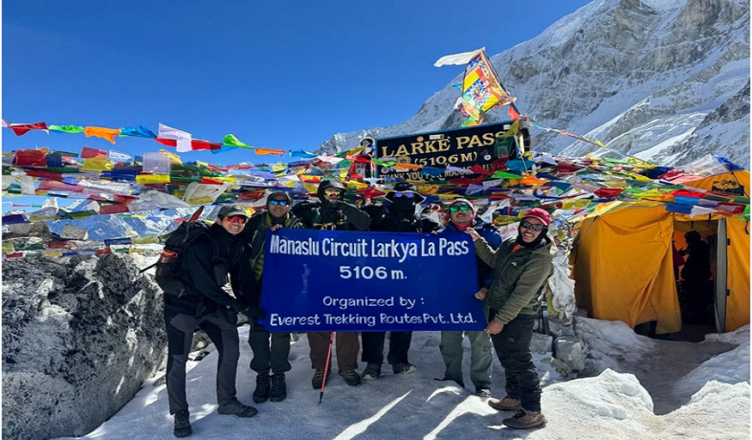Nepal is more than a goal; it is a living, breathing embroidered artwork of mountains and humankind. Extending from the tropical swamps of the Terai to the snow-clad mammoths of the Himalayas, Nepal’s scenes are as different as the individuals who occupy them. At the center of this nation’s soul lies trekking — not just as a travel through physical territory, but as a social, otherworldly, and individual exploration.
To genuinely feel Nepal’s substance, one must walk its trails, cross its suspension bridges, taste tea in nearby homes, and tune in to the noiseless shrewdness of old peaks. Among the numerous trekking courses that string through this Himalayan kingdom, four stand out for their profundity, excellence, and the lavishness they offer: the Annapurna Base Camp trek, the Langtang Valley trek, the Manaslu Circuit trek, and the Everest Three Pass Trek.
Together, these courses speak to more than experience. They epitomize Nepal’s normal glory and the ageless societies supported in its valleys. They uncover why trekking here is not fair, but a sacrosanct ceremony of passage.
Trek into the Heart of the Mountains: Annapurna Base Camp Trek
The Annapurna Base Camp trek (ABC) is frequently depicted as a walk into the heart of the Himalayas. But more than a mountain trip, it is an entry into community life, otherworldly straightforwardness, and awe-inspiring nature.
Where Timberlands Meet Glaciers
The trek regularly starts in Nayapul, a brief drive from Pokhara, Nepal’s quiet lake city. The path rises consistently through cultivating towns where Gurung and Magar communities develop terraced areas of rice and millet. You pass waterfalls cascading through rhododendron woodlands, stone staircases winding up hills, and peaceful tea houses roosted underneath towering cliffs.
As you climb past Chhomrong, Bamboo, and Deurali, the scene shifts from lavish greenery to cold scenes. In the long run, you enter the sacrosanct Annapurna Asylum, a tall frosty bowl encompassed on all sides by mountains like Annapurna I, Hiunchuli, and Machapuchare, the sacrosanct “Fishtail” crest that remains unclimbed.
Reaching Annapurna Base Camp (4,130 meters) is a strange minute. The hush here is significant, broken as it were by the whisper of wind and the crunch of snow. The morning sun sets the peak on fire in tones of gold and rose, and the whole amphitheater of mountains reflects a sense of reverence.
A Social and Otherworldly Passage
This trek, which ordinarily ranges 7 to 12 days, is not actually troublesome but remains profoundly satisfying. It offers trekkers a social inundation — halting at town religious communities, turning supplication wheels, and joining local people for dinners of dal bhat by wood-fired stoves. It’s an update that indeed at extraordinary statues, community thrives.
Walk the Covered up Path: Langtang Valley Trek
Often ignored in favor of the Everest or Annapurna districts, the Langtang Valley trek is one of Nepal’s most profound ventures. Settled north of Kathmandu, Langtang is a world of otherworldly stillness, beautiful ponder, and strong culture.
Through Timberland and Waterway into the Mountains
The trek starts from Syabrubesi, winding through the secured region of Langtang National park. The lower path passes thick timberlands lively with monkeys, ruddy pandas, and colorful winged creatures. Suspension bridges carry you over gorges where the Langtang Khola Stream surges over rocks carved by icy masses long gone.
As you rise through Lama Lodging and Langtang Town (deplorably annihilated in the 2015 seismic tremor and presently an image of resurrection), you enter scenes painted with yaks, mani dividers, and vacillating supplication banners. At Kyanjin Gompa (3,870 meters), the valley opens into a calm region of stone and snow, observed by Langtang Lirung.
Tserko Ri and the Roof of the Valley
A side climb to Tserko Ri (4,984 meters) gives all encompassing views of cold lakes, icefall cliffs, and far off Tibetan peak. The climb is soak, but the compensate is isolation and view that appear culled from another realm.
The Langtang Valley trek, as a rule completed in 7 to 10 days, is perfect for those who look for peace, culture, and a profound sense of put. It’s not as if it were a physical travel, but a contemplation on what it implies to live submissively among giants.
The Path Less Traveled: Manaslu Circuit Trek
For the traveler who needs untouched excellence and physical challenge, the Manaslu Circuit trek is a striking and exceptional way. Circling Mount Manaslu (8,163 meters), the world’s eighth most elevated top, this trek wanders through farther Tibetan-influenced towns and over towering Himalayan passes.
A Wild of Waterways and Monasteries
Beginning at Soti Khola, the path takes after the emotional pig out of the Budhi Gandaki Stream, crossing influencing suspension bridges and winding through profound forested valleys. The lower areas are lavish and tropical, with waterfalls and little settlements like Machha Khola and Jagat embracing the cliff edges.
As the path climbs into Namrung, Lho, and Sama Gaun, you enter a distinctive world — windswept levels, yak herders, and antiquated Buddhist religious communities. These towns are soaks in convention, with supplication banners hung between homes, main stones lining the ways, and ministers chanting at dawn.
Conquering Larkya La Pass
The physical climax of the trek is the crossing of Larkya La (5,106 meters), a tall, regularly snow-covered pass that offers stunning views of Cheo Himal, Himlung, and Annapurna II. It’s a long, debilitating day, but standing on the pass — with the wind on your face and the peak behind you — feels like standing on the edge of the world.
Lasting 14 to 18 days, the Manaslu Circuit requires an extraordinary permit and a direct, protecting the judgment and segregation of the region. It’s a crude and effective trek that strips absent diversion and reconnects you to the primal vitality of the earth.
Across the Most elevated Passes: Everest Three Pass Trek
While most trekkers dream of coming to Everest Base Camp, the Everest Three Pass trek goes to the distant past. It joins three of the region’s most noteworthy and most breathtaking mountain passes — Kongma La (5,535 m), Cho La (5,420 m), and Renjo La (5,360 m) — into a terrific circle of challenge, height, and exhilaration.
In the Shadow of the Giants
The trip starts in Lukla, rising through Namche Bazaar — the Sherpa capital — and veering from the classic course. It navigates through Dingboche, Chukhung, and in the long run to the to begin with major crossing: Kongma La. The climb is soak and farther, with all encompassing sees of Lhotse, Makalu, and Ama Dablam.
After coming to Everest Base Camp and climbing Kala Patthar (5,545 meters) for a close-up of Everest itself, the path heads west over Cho La, a cold course that requires a cautious route. It at that point moves to the ethereal Gokyo Lakes, a turquoise asylum underneath snow-covered cliffs, some time recently climbing the last pass — Renjo La, the most beautiful of all.
A Full Drenching in Khumbu Culture
Beyond the passes, the travel is moreover profoundly social. You’ll visit Tengboche Religious community, experience Buddhist supplication stones, and rest in Sherpa homes, frequently warmed by yak-dung stoves. The whole Khumbu region is not a trekker’s heaven — it is an otherworldly scene that lives in concordance with the tall mountains.
The Everest Three Pass trek, completed in 18 to 21 days, is a requesting but unparalleled Himalayan trek. For those with time, stamina, and a thirst for height, it is the extreme Everest experience.
The Social Soul of Nepal’s Trails
Though the mountains are amazing, it is the individuals of Nepal who shape the trekking involvement. These trails pass through old towns where conventions are honored and protected. In Annapurna, you’ll discover Gurung and Magar neighborliness, with rice porches cascading down hills. In Langtang, the Tamang legacy is apparent in cloisters, dress, and engineering. In Manaslu, Tibetan-Buddhist culture penetrates each step. In Everest, the Sherpas exemplify quality, most profound sense of being, and stewardship of the land.
Sharing a glass of butter tea, turning a supplication wheel, or basically strolling nearby a nearby doorman offers knowledge into lives molded by the arrival and the seasons. Nepal’s trekking courses are living social passages — as much around story as they are around scenery.
Practical Bits of knowledge for Your Himalayan Adventure
Best Times to Trek
Spring (March–May): Anticipate sprouting rhododendrons, steady climate, and clear skies.
Autumn (September–November): Cool temperatures and crystal-clear sees make this the most prevalent season.
Trekking Permits
- Annapurna & Langtang: TIMS card and preservation grants (ACAP/LCAP).
- Manaslu: Confined Region Allow, ACAP, MCAP — guided trek compulsory.
- Everest: Sagarmatha National park allow and Khumbu District passage fee.
Essential Pressing List
- Warm, layered clothing
- Waterproof boots and jacket
- High-quality resting bag
- Trekking poles
- Headlamp and reinforcement batteries
- Sunscreen, shades, lip balm
- First help unit and height medication
- Water decontamination tablets or filter
Conclusion:
The Himalayas are not fair mountains — they are landmarks of hush, quality, and soul. To walk over these scenes is to cross not as it were physical separations but moreover enthusiastic and otherworldly thresholds.
Each of the four treks — Annapurna Base Camp, Langtang Valley, Manaslu Circuit, and Everest Three Pass — offers a diverse voice of the Himalayas. A few whisper delicately through woodlands and streams. Others thunder through icy masses and wind-swept passes. But all carry the same message: life here is straightforward, lovely, and sacred.
To trek in Nepal is to witness the move between soil and sky. It is to feel old stones underneath and to be welcomed with a “Namaste” by outsiders who feel like family. It is to carry a piece of the Himalayas domestically with you — not in your rucksack, but in your heart.
So select your way. The soul of Nepal is standing by, tall among the peaks, prepared to be found one step at a time.
Would you like a PDF adaptation of this article, or an SEO-optimized adaptation for a site or travel web journal? I can moreover include test agendas, costs, or elevation charts on request.
Contact Details
Company address: Everest Trekking Routes Pvt. Ltd.
16 Khumbu, Nayabazaar, Kathmandu, Nepal
Mobile : +977-9843467921 (Rabin)
Email: [email protected]
URL:- www.everesttrekkingroutes.com

